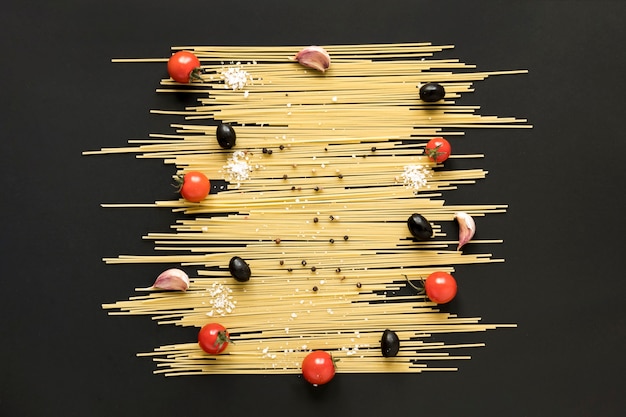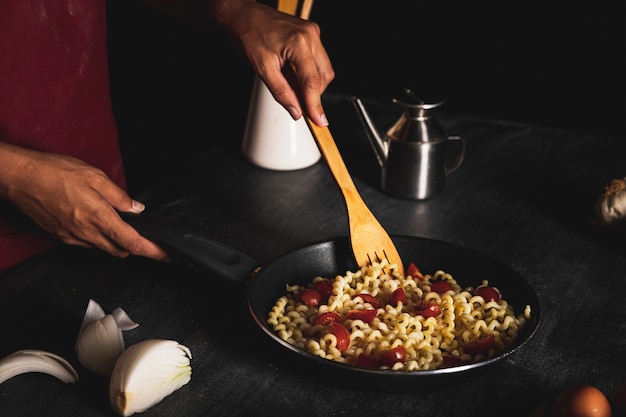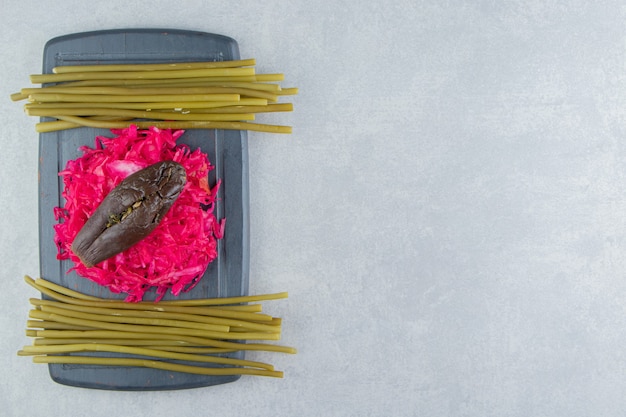(Part 1) The Pasta: It's All About the Right Noodle

The Spaghetti Family: Understanding the Differences
It's important to distinguish spaghetti from other long pasta shapes like linguine or fettuccine. While they may look similar, their shapes and textures are distinct, each best suited for different sauces. Spaghetti, with its cylindrical shape, is a true chameleon, balancing the sauce clinging to its surface with a firm, satisfying bite.Choosing Your Spaghetti: The Art of Selection
When selecting your spaghetti, consider these key factors: Shape: Look for spaghetti that’s firm, with a slightly rough surface. This helps the sauce cling to the pasta, creating a harmonious union of flavour and texture. Aim for a pasta that's neither too thin nor too thick, finding a happy medium for the perfect bite. Brand: Quality pasta makes all the difference. Don't be tempted by the cheapest option; invest in a reputable brand known for its high-quality ingredients and meticulous craftsmanship. My personal favorites include De Cecco and Barilla, but there are plenty of other exceptional options to explore. Fresh vs. Dry: While fresh pasta is a culinary delight, it might not be the ideal choice for spaghetti. Dry pasta holds its shape better during cooking, making it perfect for achieving that coveted al dente texture. It's also a more convenient option for most home cooks.cooking spaghetti: Mastering the Art of Al Dente
Now that you've chosen your pasta, it's time to turn it into the star of the show. This is where the magic of al dente comes in, that perfect balance between firmness and tenderness. It's the key to a truly satisfying spaghetti experience.Follow these steps for achieving the perfect al dente:
- Generous Water: Fill a large pot with ample salted water, about six quarts for every pound of pasta. You need enough water to ensure the pasta cooks evenly and doesn't stick together.
- Salted Symphony: Bring the water to a rolling boil and generously salt it, approximately one tablespoon per gallon. This seasons the pasta from the inside out, adding depth of flavour to every bite.
- Gentle Stir: Add the spaghetti to the boiling water and stir gently to prevent the strands from clumping together. Let the pasta dance in the boiling water.
- Timing is Key: Cook the pasta according to the package directions, aiming for al dente. This usually takes around 8-10 minutes. To test for al dente, take a piece of pasta from the pot and bite into it. It should be firm but not hard. There should be a slight resistance as you chew, but it shouldn't feel crunchy.
- Don't Overcook: Overcooked pasta will be mushy and lose its shape, ruining the texture. Respect the cooking time and avoid overdoing it.
- Reserve the Starchy Water: Once the pasta is cooked, drain it in a colander, reserving some of the starchy pasta water. This magic elixir can be used to adjust the sauce's consistency, adding richness and smoothness.
(Part 2) The Sauce: A Symphony of Flavours

Choosing the Right Sauce: A World of Possibilities
The beauty of spaghetti lies in its versatility. It's a blank canvas, ready to be adorned with a myriad of sauces, from simple and classic to complex and innovative. Let's explore some of the most beloved options:- Tomato-Based Sauce: A Classic for a Reason: This is the quintessential spaghetti sauce, a timeless favourite for good reason. Its simplicity, flavour, and versatility make it a crowd-pleaser. The secret lies in using high-quality tomatoes, letting them simmer slowly to develop depth of flavour. I like to add a touch of garlic, onion, and herbs for a more complex profile, creating a symphony of aromas and tastes.
- Creamy Sauce: Indulgence and Richness: For a richer, more luxurious experience, a creamy sauce is the perfect choice. This could be a simple carbonara, a beautiful combination of eggs, cheese, and pancetta, or a more sophisticated alfredo sauce, with cream, Parmesan, and butter creating a decadent symphony of flavours.
- Meat Sauce: Hearty and Satisfying: For a hearty, satisfying meal, a meat sauce is a winner. You can use ground beef, pork, or lamb, simmering it with tomatoes, onions, garlic, and herbs for a rich, flavourful sauce. This sauce is best made ahead of time, allowing the flavours to meld and deepen over time.
- Seafood Sauce: Light and Refreshing: For a light and summery meal, a seafood sauce is a delightful option. Think shrimp, clams, or mussels simmered in white wine and garlic, or a light tomato sauce with fresh seafood and herbs, creating a vibrant and refreshing experience.
Making Your Own Sauce: A culinary adventure
Making your own sauce is a rewarding experience. It gives you complete control over the flavour profile, allowing you to use the freshest ingredients and unleash your culinary creativity.Here are some tips for crafting the perfect sauce:
- Quality Foundation: Whether you're using canned tomatoes or fresh ones, choose high-quality ingredients. You're building the base of your sauce, so don't skimp on quality.
- Sweating the Aromatics: This crucial step adds a layer of complexity and richness to your sauce. Sauté onions and garlic in olive oil until they're soft and fragrant, releasing their intoxicating aromas.
- Slow Simmer: Allow your sauce to simmer gently over low heat for at least 30 minutes. This gives the flavours time to meld and deepen, creating a symphony of taste.
- Generous Seasoning: Don't be shy with the salt, pepper, and herbs. They are the symphony's instruments, adding layers of flavour that will make all the difference.
Using Store-Bought Sauce: A Time-Saving Option
Let's be honest, sometimes we don't have the time to embark on a full-blown sauce-making adventure. That's okay! There are plenty of excellent store-bought sauces available, ready to save you time and elevate your spaghetti.Here are some tips for using store-bought sauce:
- Choose Wisely: Not all store-bought sauces are created equal. Do your research and choose a reputable brand known for using quality ingredients. Look for sauces with simple ingredients lists, avoiding those packed with artificial flavors and preservatives.
- Enhance the Flavour: Don't be afraid to add your own personal touch to the store-bought sauce. A splash of red wine, a squeeze of lemon juice, or some fresh herbs can elevate the flavour profile to new heights.
- Simmer for Depth: Even though it's store-bought, simmering the sauce for a few minutes will allow the flavours to develop and meld, adding complexity and depth.
(Part 3) The Toppings: Adding the Finishing Touches

A Symphony of Toppings: Classic Combinations
The topping options are endless, but here are some classic favourites that will never disappoint:- Parmesan Cheese: The Essential Element: A sprinkle of freshly grated Parmesan cheese is a must-have for any spaghetti dish. It adds a salty, umami flavour that complements any sauce, creating a harmonious union of taste and texture.
- Fresh Basil: A Touch of Freshness: A handful of fresh basil leaves adds a vibrant, herbaceous flavour and a beautiful visual touch to your spaghetti, enhancing both taste and presentation.
- Red Pepper Flakes: A Spark of Heat: For a touch of heat, sprinkle on some red pepper flakes. This is especially delicious with tomato-based sauces, adding a subtle kick that awakens the taste buds.
- Garlic Bread: The Perfect Companion: This classic Italian side dish is perfect for dipping in your spaghetti sauce, adding a garlicky, buttery flavour to the experience.
- A Pinch of Salt: Enhances Flavours: A sprinkle of salt on top of your spaghetti will enhance the flavours of the sauce and the pasta itself, bringing out the best of each ingredient.
Beyond the Basics: Unleash Your Creativity
Don't be afraid to experiment and get creative with your toppings. The possibilities are endless, allowing you to personalize your spaghetti with your own unique touch.Here are a few ideas to ignite your culinary imagination:
- Sun-dried Tomatoes: Add a burst of sweetness and umami to your spaghetti with chopped sun-dried tomatoes, creating a complex and satisfying flavour profile.
- Mushrooms: Sautéed mushrooms are a delicious addition to any spaghetti dish, adding a meaty texture and earthy flavour. Experiment with different varieties for a taste adventure.
- artichoke hearts: artichoke hearts bring a delicate, briny flavour and a lovely texture to your spaghetti, adding a touch of elegance to the dish.
- Spinach: Fresh spinach wilts beautifully in the heat of the pasta, adding a nutritious boost and a vibrant green hue to your plate.
- Roasted Vegetables: Add a touch of sweetness and depth of flavour to your spaghetti with roasted vegetables like bell peppers, zucchini, or eggplant, creating a symphony of textures and tastes.
(Part 4) Serving the Perfect Spaghetti: Presentation is Key
You've poured your heart and soul into creating the perfect spaghetti. Now it's time to serve it up with style. Don't underestimate the power of presentation; a beautiful plate of spaghetti can be just as satisfying as a delicious one.Presentation Matters: Setting the Stage
Here are some tips for serving your spaghetti with finesse:
- Choose the Right Plate: Use a shallow plate that will show off the beautiful pasta and sauce, allowing the colours and textures to shine.
- Use a Pasta Spoon: A pasta spoon is the ideal tool for serving spaghetti. Its unique shape allows you to scoop up the pasta without breaking it, preserving its integrity and beauty.
- Garnish with Flair: Don't be afraid to get creative with your garnishes. A sprinkle of Parmesan cheese, a sprig of basil, or a drizzle of olive oil can elevate your presentation, adding a touch of artistry to your dish.
The Art of Twisting the Spaghetti: A Culinary Dance
One of the most important elements of serving spaghetti is the iconic "twist." It not only looks beautiful but also helps prevent the pasta from slipping off the plate, ensuring every bite is a delicious experience.Here's how to twist your spaghetti like a pro:
- Fork and Spoon Collaboration: Hold the fork in your left hand and the spoon in your right hand. These are your tools for creating culinary magic.
- Scoop and Twirl: Use the spoon to scoop up a generous portion of spaghetti. Then, with the fork, gently twist the spaghetti around the spoon, creating a beautiful spiral of pasta.
- Slide Onto the Plate: Gently slide the twisted spaghetti onto the plate, allowing it to nestle in its new home with grace and elegance.
(Part 5) The Spaghetti Experience: Beyond the Plate
Spaghetti isn't just about the food; it's about the atmosphere, the company, and the memories you create.Atmosphere Matters: Setting the Mood
The right atmosphere can make all the difference in your spaghetti experience. A cozy dining room, soft lighting, and good music can set the stage for a memorable meal, creating a warm and inviting ambience.The Power of Conversation: Sharing and Connecting
Sharing a meal with loved ones is a beautiful thing. Put away your phones and enjoy each other's company, engage in meaningful conversations, and build deeper connections.Creating Memories: Moments to Cherish
Spaghetti is an opportunity to create lasting memories. Share your love for this dish with friends and family, creating moments you'll cherish for years to come.(Part 6) The Spaghetti Journey: A Continuous Evolution
Don't be afraid to experiment and try new things; your spaghetti journey is a constant evolution, a culinary adventure that never ends.Trying New Sauces: Expanding Your Horizons
As you become more experienced, you'll discover a world of new sauces to explore. From classic Italian sauces to more adventurous creations, there's always something new to try, constantly expanding your culinary repertoire.Experimenting with Toppings: Personalize Your Plate
Don't be afraid to get creative with your toppings. Try different cheeses, herbs, spices, and vegetables, adding your own personal touch to your spaghetti masterpiece.Sharing Your Creations: Spreading the Love
Share your spaghetti creations with friends and family. Ask for feedback, see what they think, and learn from their experiences. You may even discover your next favourite recipe!(Part 7) The Spaghetti Legacy: Passing on the Passion
Spaghetti is more than just a dish; it's a tradition, a part of our culinary heritage that we pass down through generations.Teaching Others: Sharing the Joy
Share your love for spaghetti with the next generation. Teach your children, grandchildren, or friends how to make this beloved dish, passing on the culinary skills and traditions that have brought joy for generations.Creating Family Traditions: Shared Moments
Make spaghetti a regular part of your family life. Turn it into a weekly tradition, a special occasion meal, or a way to celebrate holidays, creating shared memories and bringing people together.Building Memories: The Essence of Spaghetti
Each plate of spaghetti is an opportunity to build memories and connect with loved ones, creating a tapestry of shared experiences and a legacy of culinary joy.(Part 8) FAQs
Q: How do I store leftover spaghetti?
Leftover spaghetti can be stored in an airtight container in the refrigerator for up to 3 days. When reheating, add a splash of pasta water to the container and microwave on high for 1-2 minutes, or until heated through. This will help rehydrate the pasta and ensure a smoother, more flavorful reheating experience.
Q: Can I freeze spaghetti?
You can freeze cooked spaghetti, but it's best to freeze it with the sauce. To freeze, place the spaghetti in a freezer-safe container or bag and freeze for up to 3 months. When reheating, thaw overnight in the refrigerator or microwave on low for 5-10 minutes.
Q: What if my spaghetti is too sticky?
If your spaghetti is too sticky, it may be because you didn't add enough salt to the cooking water or because you overcooked it. You can try adding a splash of pasta water to the sauce to loosen it up, restoring the balance of texture and flavour.
Q: What if my spaghetti is too dry?
If your spaghetti is too dry, you can add more sauce or a splash of pasta water to the dish. You can also try adding some grated cheese to the sauce to help bind it together, creating a richer, smoother consistency.
Q: How do I make spaghetti without gluten?
There are many gluten-free spaghetti options available in the market. Look for pasta that is made from rice, quinoa, or chickpeas. These gluten-free alternatives will allow you to enjoy the taste and texture of spaghetti without the gluten.
Everyone is watching

Prime Rib Roast Cooking Time Chart: Per Pound Guide
Cooking TipsPrime rib roast. Just the name conjures images of lavish dinners, crackling fires, and hearty laughter. It’s ...

How Long to Bake Potatoes in the Oven (Perfect Every Time)
Cooking TipsBaked potatoes are a staple in my kitchen. They're incredibly versatile, delicious, and surprisingly easy to m...

Perfect Rice Every Time: The Ultimate Guide to Cooking Rice
Cooking TipsAs a self-proclaimed foodie, I've always been a bit obsessed with rice. It's the foundation of countless cuisi...

The Ultimate Guide to Cooking Asparagus: Tips, Techniques, and Recipes
Cooking TipsAsparagus. The mere mention of this spring delicacy conjures up images of vibrant green spears, crisp and burs...

Ultimate Guide to Cooking the Perfect Thanksgiving Turkey
Cooking TipsThanksgiving. Just the word conjures up images of overflowing tables laden with delicious food, the scent of r...
